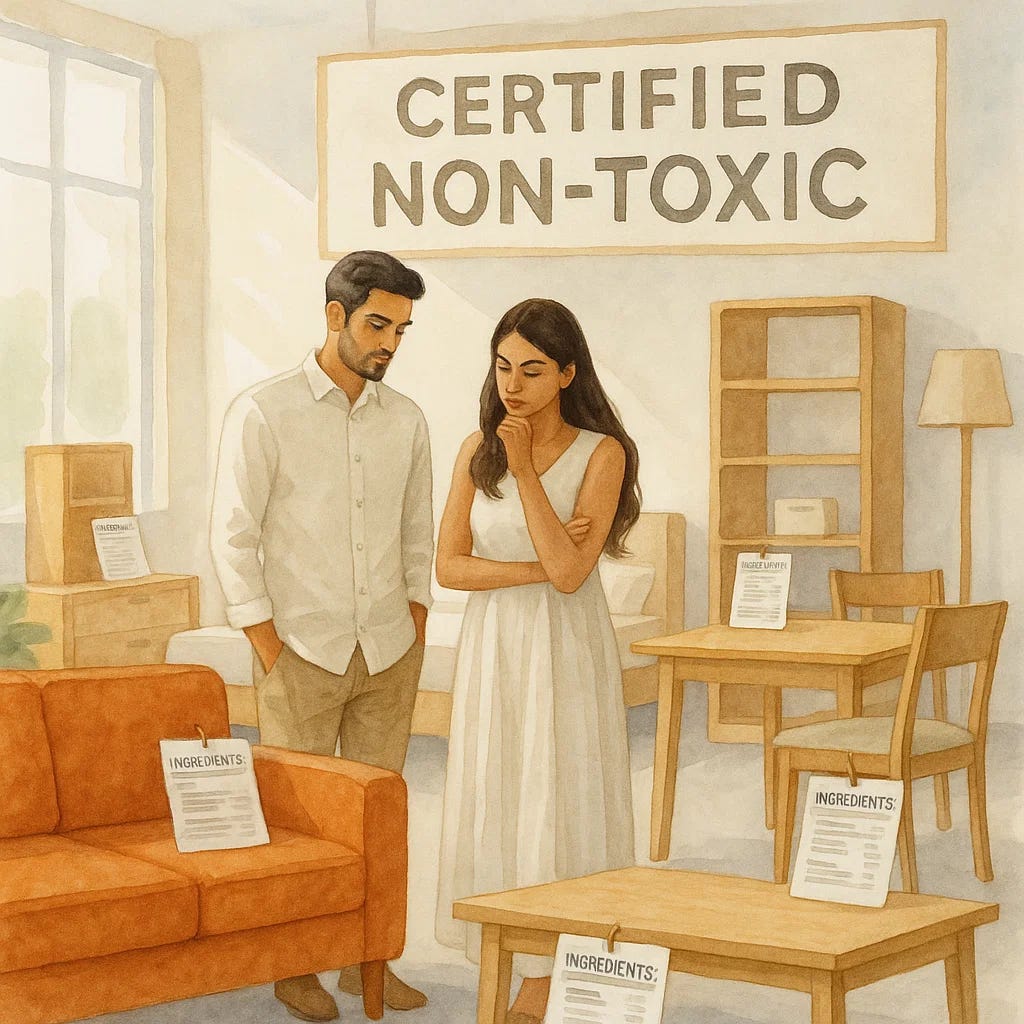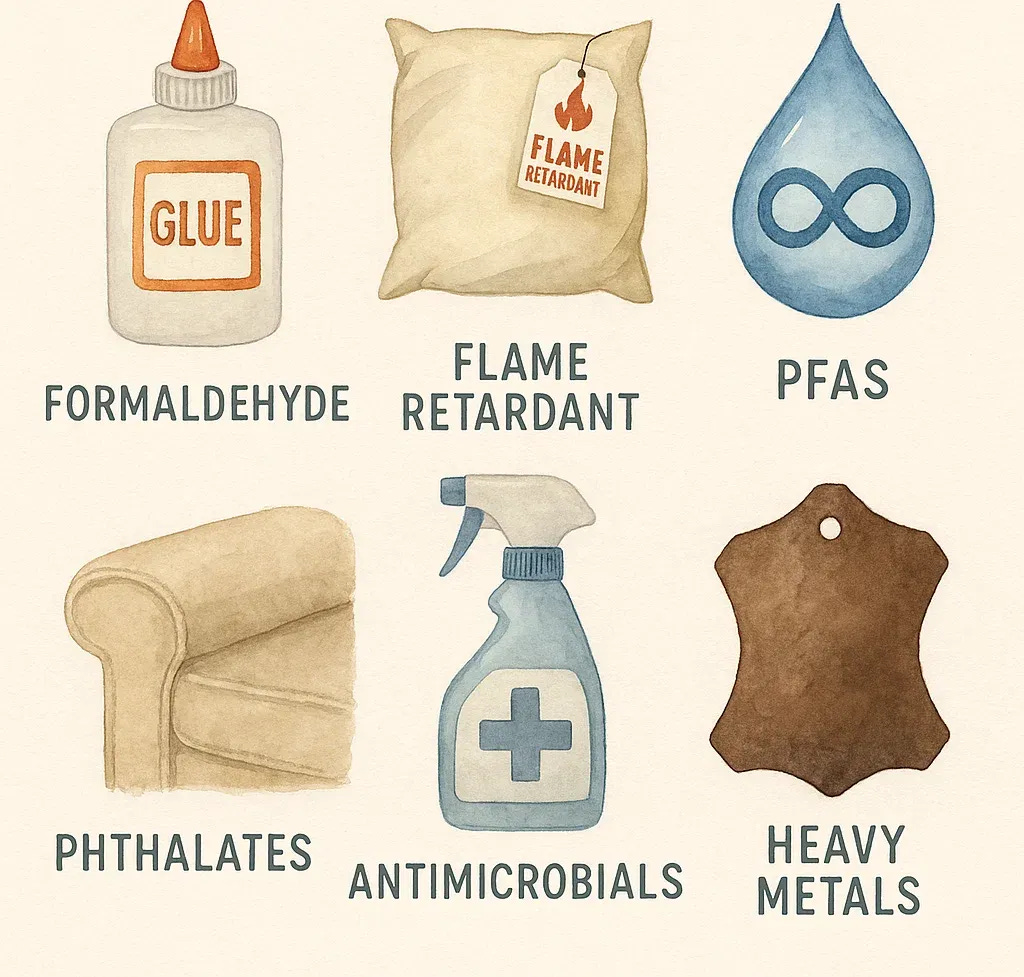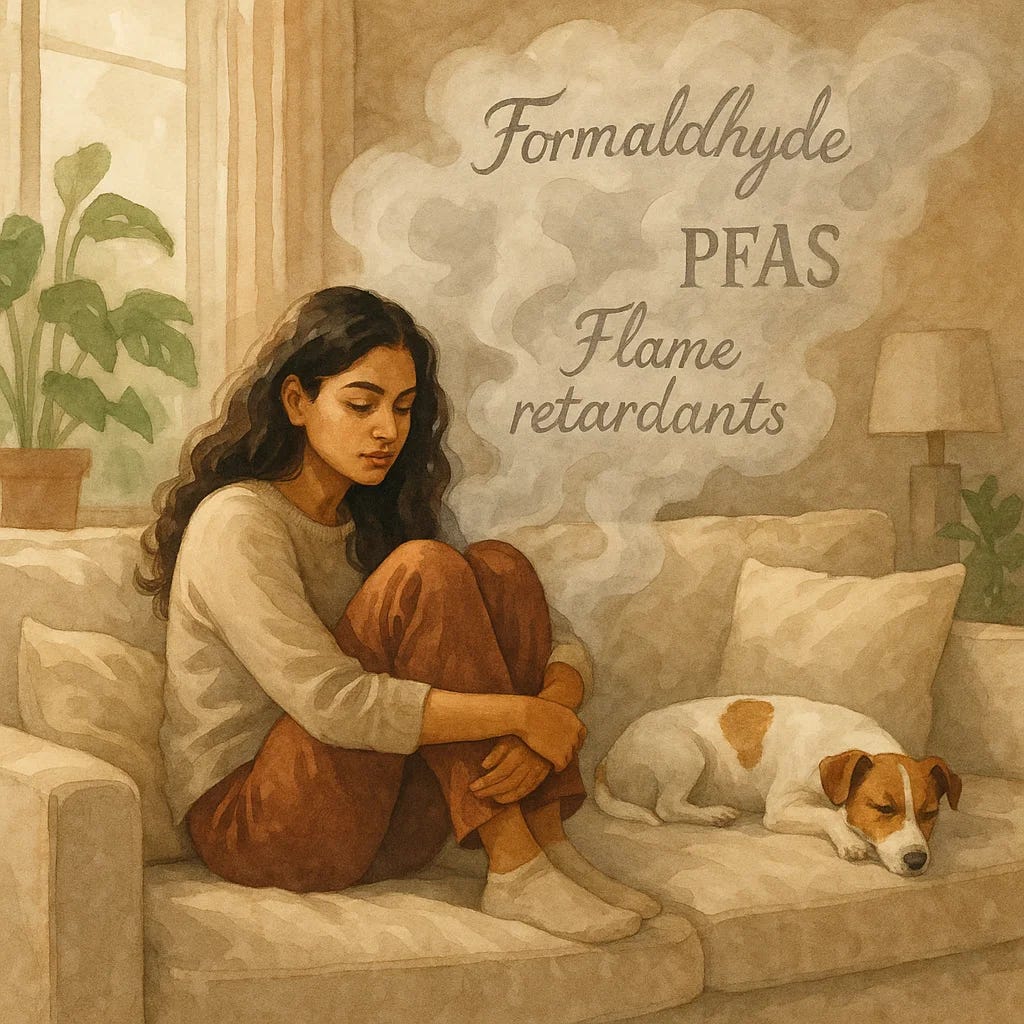The Hidden Chemical Cocktail in Your Living Room: What Your Furniture Isn't Telling You
When I started investigating what was wreaking havoc on my hormones, I went down every rabbit hole you can imagine.
Nutrition, stress, sleep, skincare... But furniture?
That beautiful sofa I'd just bought. Never crossed my mind that it could be silently disrupting my endocrine system every single day.
But sadly, it does.
Fast forward to last month, when I went furniture shopping with a friend. What should have been a fun afternoon turned into an exercise in frustration. Store after store, I tried an experiment and asked simple questions:
“What's in this foam?” or “What chemicals are used in this stain treatment?”
The only response: Blank stares.
Here's what they're not telling you, and what I wish every furniture store was required to display in bold letters on every price tag.
The Invisible Threat Living in Your Home
That 'new furniture smell' you've learned to associate with a fresh purchase? It's not the scent of quality or newness.
It's the chemical signature of volatile organic compounds (VOCs) off-gassing into your air.
The same air you breathe 15,000 times a day.
Indoor air pollution levels are consistently 2–5 times higher than outdoor air and can spike up to 100 times higher. Furniture is one of the primary culprits.
Think about it: you spend a third of your life sleeping on your mattress, hours every day on your sofa, at your desk.
These aren't just decorative pieces, they're close contacts, silently releasing toxins you inhale and absorb through your skin.
The Chemical Cast of Characters
Formaldehyde - A known carcinogen, commonly found in the glues used in particleboard, MDF, and plywood. It's what holds your bookshelves, dining tables, and budget-friendly dressers together.
Flame Retardants - Found in up to 85% of foam furniture in the US. The original PBDEs were phased out for toxicity- but replaced with TDCPP, which was banned in kids' pyjamas decades ago.
PFAS (Forever Chemicals) - Used in stain- and water-resistant coatings. They bioaccumulate in the body and have been linked to thyroid issues, fertility decline, cancer, and more.
VOCs - Benzene, toluene, xylene: just a few of the vapours evaporating from your finishes, adhesives, and synthetic foams.
Phthalates - Plastic softeners in vinyl furniture components. Known hormone disruptors.
Antimicrobials - Like triclosan, added to inhibit mould or bacteria but contribute to resistant 'superbugs.'
Heavy Metals - Lead, chromium, cadmium still lurking in finishes, dyes, and treated leathers.
Preservatives - Found in outdoor furniture to prevent rot (like pentachlorophenol) but can pose serious long-term health risks.
The science is crystal clear on this: chronic exposure to furniture chemicals affects your health in measurable ways.
Short-term symptoms include:
Eye, nose, and throat irritation
Headaches and dizziness
Fatigue and brain fog
Respiratory issues and worsened asthma
Skin irritation and rashes
But it's the long-term effects that should really concern you:
Increased cancer risk from multiple chemical exposures
Hormone disruption affecting fertility, thyroid function, and metabolism
Developmental problems in children, including learning difficulties and behavioral issues
Weakened immune system function
Liver and kidney damage
And here's what really gets me fired up:
Children and pregnant women face the highest risk.
Children crawl on floors, put their hands in their mouths, and spend more time in close contact with furniture surfaces. Their developing systems are extraordinarily vulnerable to these chemical exposures.
Pregnant individuals are also highly sensitive, with exposure to PFAS linked to an increased risk of high blood pressure during pregnancy.
And let's not forget our best pals, our beloved pets, whose paws and fur are exposed to everything as they walk around the floor and jump up the furniture.
The toxic exposure is way higher for their little bodies compared to ours.
Off-Gassing: What It Is and Why It Matters
Off-gassing is the process where chemicals trapped in solid materials (like foam or pressed wood) slowly release into the air.
It’s that chemical smell you notice with new sofas, carpets, or freshly painted walls.
Worse in:
High temperatures
High humidity
Poorly ventilated spaces
Even with "low-VOC" claims, off-gassing can continue for years, just at lower levels.
My Turning Point
Before I learned about this, I used to curl up on my gorgeous cream sofa every evening, thinking it was the safest space in the house.
It was my sanctuary, watching a movie, reading a book, cuddling with my dog.
Little did I know it wasn’t the innocent haven I thought it was.
And then, I completely remember the time I slept in my new bedroom with a natural latex mattress and my mum’s old antique cupboard and bedside tables.
That was it. My body exhaled. My scratchy throat eased.
I slept better.
It’s not magic, it’s just removing the stuff that doesn’t belong.
The Regulatory Shell Game
The furniture industry isn’t tightly regulated. When one chemical gets banned, it’s often replaced by another equally problematic one.
Transparency is minimal.
Most manufacturers don’t list their materials. And interior designers rarely get trained in material health.
California’s new smouldering-resistance standard sounds like progress, but fire barrier materials like fibreglass are now also on their way out (banned by 2027), meaning manufacturers may revert to chemical treatments unless policy keeps pace.
The 'New Normal' That Shouldn't Be Normal
Here's what strikes me most about this entire situation: we've normalised living in a chemical soup.
We've accepted that furniture off-gasses, that new purchases come with weeks of “airing out’’, that indoor air quality is just... worse.
But what if I told you it doesn't have to be this way?
What if furniture stores were required to post chemical content labels next to price tags?
What if interior designers received training on material toxicity alongside colour theory?
What if manufacturers competed on health metrics, not just aesthetics and price?
This isn't some impossible dream. We demand ingredient lists on food products.
We expect safety ratings on cars. Why should furniture - the pieces we live with intimately every day - be any different?
The Power in Your Hands
The frustrating truth is that right now, the burden falls on you, the consumer, to navigate this chemical maze.
But here's the empowering truth: you have more control than you realise.
Every purchase decision is a vote for the kind of world you want to live in. Every question you ask a furniture salesperson signals market demand for transparency. Every time you choose a certified non-toxic option, you're supporting manufacturers who prioritise health over shortcuts.
Your home should be your sanctuary, not a source of chronic chemical exposure.
You deserve to know what you're bringing into your space, what you're breathing every day, what's affecting your hormones, your sleep, your family's health.
The chemicals hiding in your furniture aren't just statistics in research papers - they're real substances affecting real bodies in real homes.
Your body. Your home.
And that matters far more than any marketing claim or price point ever could.
Up Next: How to Actually Shop for Non-Toxic Furniture
In my next post, I break down exactly what to look for (and what to avoid), the certifications that actually mean something, and simple ways to detox your space—even on a budget.
Because it’s not about being perfect. It’s about doing better.







